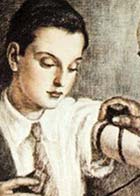Tefillin

"This refers to the tefillin worn on the head," commented a first-century sage on a verse in Deuteronomy (28:10): "And all the peoples of the earth will see that you are called by God's name, and they will fear you." Fear is right. Last Thursday, the sight of a mild-mannered student wearing tefillin for his morning prayers terrified a U.S. Airways crew into an emergency landing.
Tefillin, or, in ungainly English, phylacteries, strike a primal chord in those who wear them as in those who see them, and with reason. Tefillin physically enact the biblical injunction to make the words of Torah a sign written on the hand and a "frontlet" between the eyes. Miniature scrolls of verses from Scripture, each enclosed in a leather box and held by leather straps on the arm and head of the worshipper, they offer a powerful emblem of Judaism's yoking of spirituality with embodiment.
The practice of wearing tefillin has reflected and shaped currents of Jewish history. During the Second Temple period, observance of this biblical commandment emerged as a Jewish answer to Hellenistic amulets. In the late Middle Ages, a comment on tefillin in the Zohar sparked a centuries-long controversy over whether mysticism could be a basis for religious law. The 18th-century Gaon of Vilna, who enshrined Torah study as the supreme religious act, wore tefillin all day. So, closer to our time, did the lyrical mystic Rav Kook (1865–1935).
Today, the Hasidic organization Chabad presses tefillin on male passers-by at street corners, while Jewish women, most though not all of them non-Orthodox, increasingly incorporate them into their religious practice. Undoubtedly, the source of tefillin's protean meaning and power lies in their very opacity. As a religious commandment and an exercise in mindfulness, a marker of identity and a provocation to others, they are indeed different, and at times a little strange. Just like the Jews who wear them.
Comments are closed for this article.




